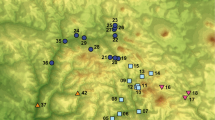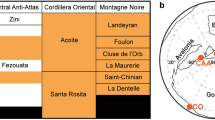Abstract
The silica-scaled chrysophytes—here mainly represented by the freshwater genera Mallomonas and Synura—have special problems in dispersal from one habitat to another because they cannot tolerate desiccation. Their dispersal is limited by the fragile construction and aquatic habit. Dispersal from one water body to another involves dangerous changes of the environment, and the ability to avoid desiccation during transport is crucial. So, air-borne and ectozoic dispersal by birds or mammals can only work at short distances. This danger may be avoided by endozoic dispersal of thick-walled cysts; as far as they can tolerate the digestion fluids in the intestine. In spite of these difficulties, Chrysophytes have been dispersed worldwide, but they display various distinct distribution patterns, e.g., cosmopolitan, arctic-northern temperate, bipolar, and tropical. Quite a large proportion may be considered endemic, occurring only within a restricted area. Even if the exact dispersal methods are elusive, the distribution of chrysophytes around the world proves their ability for dispersal. On the other hand, the different degree of distribution shows the varying success of the individual species. The distribution of a species at a given time depends on several factors: dispersal capacity—available vectors—suitable available habitats—and most important: sufficient time for dispersal. It is remarkable that the chrysophytes—in spite of their fragile cell construction and apparently low dispersal capacity—show distribution types comparable to those found in, e.g., blue–greens and desmids, whose cell construction appears much better adapted for dispersal.




Similar content being viewed by others
References
Coesel PFM (1996) Biogeography of desmids. Hydrobiologia 336:41–53
Dumont HJ, Cocquit C, Fontugne M, Arnold M, Reyss J-L, Bloemendal J, Oldfield F, Steenbergen CLM, Korthals HJ, Zeeb BA (1998) The end of moai quarrying and its effect on Lake Rano Raraku, Easter Island. J Paleolimnol 20:409–422
Finlay B, Clark KJ (1999) Apparent global ubiquity of species in the protist genus Paraphysomonas. Protist 150:419–430
Hansen P (2001) Chrysophyte stomatocysts in the Azores—biogeographical implications and 110 new morphotypes. Opera Bot 138:1–96
Hansen P, Johansen JE, Skovgård A et al (1993) Mallomonas palaestrica sp. nov., a new member of sect. Torquatae from Denmark. Nord J Bot 13:107–110
Hoffman L (1996) Geographic distribution of freshwater blue-green algae. Hydrobiologia 336:33–40
Kristiansen J (1961) Sexual reproduction in Mallomonas caudata. Bot Tidsskr 57:306–309
Kristiansen J (1975) On the occurrence of the species of Synura. Verhandl Internat Verein Limnol 19:2709–2715
Kristiansen J (1996a) Silica structures in the taxonomy and identification of scaled chrysophytes. Nova Hedwigia, Beih 112:355–365
Kristiansen J (1996b) Dispersal of freshwater algae—a review. Hydrobiologia 336:121–126
Kristiansen J (2001a) Biogeography of silica-scaled chrysophytes. Proceedings of the fifth international chrysophyte symposium. Nova Hedwigia, Beih 122:23–39
Kristiansen J (2001b) Cosmopolitan chrysophytes. Syst Geogr Plants 70:291–300
Kristiansen J (2005) Golden algae—a biology of chrysophytes. Gantner Verlag, Koenigstein
Kristiansen J, Lind JF (2005) Endemicity in silica-scaled chrysophytes. Proceedings of the sixth international chrysophyte symposium. Nova Hedwigia, Beih 128:65–83
Kristiansen J, Menezes M (1998) Silica-scaled chrysophytes from an Amazonian flood-plain lake, Mussurá lake, northern Brazil. Algol Stud 90:97–118
Kristiansen J, Preisig HR (2007) Süsswasserflora von Mitteleuropa, vol 1, part 2, Synurophyceae. Spektrum Akad Verlag, Heidelberg
Kristiansen J, Vigna MS (1996) Bipolarity in the distribution of silica-scaled chrysophytes. Hydrobiologia 336:151–157
Lee W, Patterson DJ (1998) Diversity and geographic distribution of free-living heterotrophic flagellates—analysis by PRIMER. Protist 149:229–244
Munch S (1980) Fossil diatoms and scales of Chrysophyceae in the recent history of Hall Lake, Washington. Freshw Biol 10:61–66
Nicholls KH (1989) Description of four new Mallomonas taxa (Mallomonadaceae, Chrysophyceae). J Phycol 25:292–300
Nicholls KH (2001) New and little known Mallomonas (Synurophyceae) taxa from Ontario, Canada. Nord J Bot 21:551–560
Péterfi LS, Momeu L (1996) Three Rumanian Mallomonas species (Synurophycae) with special distribution patterns. Hydrobiologia 336:143–150
Řezáčová M, Neustupa J (2007) Distribution of the genus Mallomonas (Synurophyceae)—ubiquitous dispersal in microorganisms evaluated. Protist 158:29–37
Sandgren CD (1988) The ecology of chrysophyte flagellates: their growth and perennation strategies as freshwater phytoplankton. In: Sandgren CD (ed) Growth and reproduction strategies of freshwater phytoplankton. Cambridge University Press, Cambridge, pp 9–104
Sandgren CD, Flanagin J (1986) Heterothallic sexuality and density dependent encystment in the chrysophyte alga Synura petersenii. J Phycol 22:675–692
Schlichting HE (1960) The role of waterfowl in the dispersal of algae. Trans Am microsc Soc 79:160–166
Siver PA (1991) The biology of Mallomonas. Kluwer, Dordrecht
Smol JP, Charles DF, Whitehead DR (1984) Mallomonadacean (chrysophycean) assemblages and their relationships with limnological characteristics in 38 Adirondack (New York) lakes. Can J Bot 62:911–923
Tyler PA (1996) Endemism in freshwater algae. Hydrobiologia 336:127–135
Van de Vijver B, Beyens L (1997) The chrysophyte stomatocyst flora of the moss vegetation from Strømness Bay area, South Georgia. Arch Protistenk 148:505–520
Wawrik F (1972) Isogame Hologamie in der Gattung Mallomonas. Nova Hedwigia 23:353–362
Wee JL, Booth DJ, Bossier MN (1993) Synurophyceae from the southern atlantic coastal plain of North America: a preliminary survey in Louisiana, USA. Nord J Bot 13:95–106
Wee JL, James AM, Hood CS (2005) Exploratory investigations of palmella-stage formation in the Synurophyceae. Nova Hedwigia, Beih 128:257–266
Author information
Authors and Affiliations
Corresponding author
Additional information
Special Issue: Protist diversity and geographic distribution. Guest editor: W. Foissner
Rights and permissions
About this article
Cite this article
Kristiansen, J. Dispersal and biogeography of silica-scaled chrysophytes. Biodivers Conserv 17, 419–426 (2008). https://doi.org/10.1007/s10531-007-9259-2
Received:
Accepted:
Published:
Issue Date:
DOI: https://doi.org/10.1007/s10531-007-9259-2




